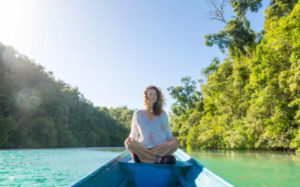Raja Ampat Conservation Efforts
Learn more
Protecting the Birds Head Seascape
The Bird’s Head Seascape initiative was established in 2004. Dependent on the strong union of international NGOs and local, regency, provincial and national governments, coastal communities, local organizations, and universities, the initiative seeks to balance the needs of the Seascape’s human population while effectively protecting its rich natural resources. The Bird’s Head’s network of 12 multiple-use marine protected areas (MPAs) form the core of this initiative. The BHS exemplifies the priorities of the six-nation Coral Triangle Initiative, and is being promoted as a national model for Indonesia’s future marine resource management.
Over the past dozen years, the Walton Family Foundation has helped local communities in Indonesia protect the Bird’s Head Seascape. The foundation’s history with the Bird’s Head Seascape is very much a history of the Walton family’s relationship with this area. In the early 2000s, Rob Walton was on the board of Conservation International. He was passionate about supporting conservation in this part of the world, especially after traveling there and seeing it for himself.
Thanks to local enforcement teams patrolling the MPAs, overfishing by outside poachers has been reduced by 90%, which means more fish for local fishers and greater food security for communities.
Shark, Manta Ray and Dugong Sanctuary
In February 2014 Indonesia declared a vast sanctuary for dugongs, sharks, turtles and manta rays in Raja Ampat. The sanctuary covers 46,000 square ilometres (17,760 square miles) of waters around the Raja Ampat islands.
Sharks, manta rays, mobulas, dugongs and turtles are fully protected within the sanctuary, and destructive practices, including reef bombing and the aquarium fish trade, are banned. As the Walton Family Foundation reports, “With support from the Walton Family Foundation, Conservation International and The Nature Conservancy the local government of Raja Ampat established the approximate 18,000 square-miles of ocean surrounding the Raja Ampat islands as a shark and manta ray sanctuary, the first in Indonesia and one of only a few in the world. The shark sanctuary is already inspiring broader change. The bold step of the Raja Ampat government has inspired the national Ministry of Marine Affairs and Fisheries to follow suit, with the Ministry currently considering a national ban on manta ray harvest and protection for the most endangered shark species. Given that Indonesia has the highest rate of shark fishing in the world, the shark sanctuary could be a game changer for shark populations globally.”
Through the efforts of a coalition of concerned parties, including Conservation International, The Nature Conservancy, Shark Savers and Misool Eco Resort – all grantees of the Walton Family Foundation – advocates worked with local policymakers to put in place protections for sharks and rays that will also benefit the region’s burgeoning tourism industry. With the creation of the shark sanctuary and a total ban on shark capture and sale, Raja Ampat’s sharks can again rule the reefs.
Guardians of Raja Ampat
Watch the video to understand how and why the community is strongly committed to the conservation of this unique place in the world. The video harnesses the voices of the community, connecting the people of Raja Ampat to their own story as well as government officials which helped to start a new birth of commitment to conservation.
Are there other parts in Papua and West Papua for diving and snorkelling?
With a total of 1.5million hectares, Cenderawasih Bay became the largest marine protected area in August 2002.
It has been referred to as a place where time stands still. The 20 000 inhabitants have not left much of a footprint on the land scape.
- Due to the movement of the tectonic plates millions of years ago, the influence on the ocean currents and tides that affect the movement of the larvae, has decreased. When the plates finally shifted again, they became an island known today as Halmahera. Those movements caused the reef in Cenderawasih Bay to develop into a unique area.
- The corals from the depths where pushed closer to the surface over time, changing the characteristics of certain fish.
Cenderawasih Bay has over 500 species of coral found on the atolls in the bays at many dive sites. When they first discovered the area, they still had not identified 30 percent of the corals. There are wall dives where you will come across numerous corals layered upon each other of different sizes.
You will also find the Whale Shark in this area, which is usually around the floating lift-net platforms. The sharks wait around the platforms to feed the small bait fish that are caught in the nets. The locals believe that the Whale Shark brings good luck and so this is why they feed them.
There are a few sunken patrol boats and a freighter found in Manokwari, within dive limits.
The diving in Triton Bay is quite distinct from other locations in West Papua. Rather than prolific hard corals and good visibility, Triton Bay’s high level of nutrients means reduces visibility, but offers a lot more fish life. In fact the high biomass of species such as grouper, sweetlips and snapper was one of the main reasons that led to Kaimana and Triton Bay being declared a Marine Protected Area. Dive sites in the bay are home to giant groupers, napoleon wrasse, eagle rays, schooling barracuda and jacks and a huge range of other reef fish, including clouds of baitfish, anthers, fusiliers and surgeonfish which gather in huge numbers to feed on the rich plankton. Triton Bay is also home to some very interesting macro diving – including flasher wrasse and pygmy seahorses – and is great for spotting wobbegong and walking sharks.
One of Triton Bay’s biggest draws are the whale sharks which congregate around fishing platforms known as ‘bagans’ to feed on anchovies and other baitfish caught in the nets. These platforms target different species of fish at different times of year so encounters with the whale sharks are never guaranteed. But if divers time their visit to the dark of the moon when the fishing around the bagans is at its best, they stand a very good chance of swimming with these huge sharks.
Biak is a small island located in Cenderawasih Bay near the northern coast of Papua and is the largest island in its small archipelago with many atolls, reefs, and corals. It has great diving, including wrecks and the outstanding diversity of the region. It is also a great destination for birdwatchers!
The rain forest-covered Biak Islands have been designated the Biak-Numfoor rain forests, especially as they have the largest number of endemic bird species of any single area in the New Guinea region. There are also numerous reptile and amphibian species found here. Among the many snake species catalogued by Tom Mendelson during his herpetological survey of Biak in the 1990s, the green tree python (Morelia viridis) and the amethystine python (Morelia amethystina) were quite common. The Biak glider is a recently reclassified gliding possum species, formerly considered a sugar glider subspecies.
YOU MAY ALSO LIKE

What is the Geography of the Raja Ampat area?
Raja Ampat can be classified into three sectors, the North, Central and South.
- The North of Raja Ampat consists of the main Islands Wayag, Uranie & Kawe
- Central Raja Ampat consists of the main regions West Waigeo, Dampier Strait, Batanta Island & Fam Islands
- The South of Raja Ampat consists of the main Islands Kofiau & Misool

Raja Ampat as a Marine Park
In May 2007, the Raja Ampat government declared a network of seven MPAs (Marine Protected Areas). Today, there are 10 MPAs that altogether cover nearly 35,000 square kilometres, and approximately 45% of Raja Ampat’s coral reefs and mangroves. We hope that these MPAs will ensure the long-term health and sustainability of Raja Ampat’s marine ecosystems.

























